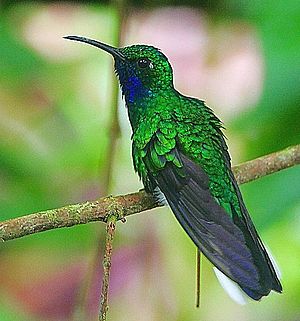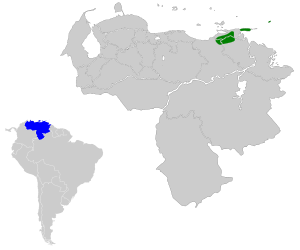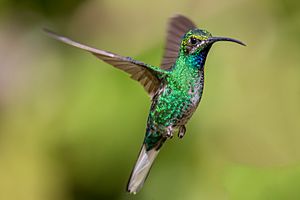White-tailed sabrewing facts for kids
Quick facts for kids White-tailed sabrewing |
|
|---|---|
 |
|
| Conservation status | |
| Scientific classification | |
| Genus: |
Campylopterus
|
| Species: |
ensipennis
|
 |
|
The white-tailed sabrewing (Campylopterus ensipennis) is a beautiful type of hummingbird. It gets its name from its unique wing shape. This bird lives on the island of Tobago and in the country of Venezuela. It is considered a Near Threatened species, which means it needs our help to protect it.
Contents
About the White-tailed Sabrewing
The white-tailed sabrewing is a special kind of hummingbird. It is the only species in its group, meaning it does not have any close relatives that are also called "sabrewings."
What Does It Look Like?
The white-tailed sabrewing is about 12 to 13 centimeters (5 inches) long. That's about the length of a pen! Males are a bit heavier than females.
Both male and female sabrewings have a black beak that curves downwards. They also have a small white spot right behind their eye.
- Males: They have shiny green feathers on their upper body. Their throat is a bright, shimmering blue or dark purple. Their belly is also a sparkling green. The two middle feathers of their tail are dark green. The outer tail feathers are black at the base and white at the ends.
- Females: They look similar to males but are a bit less colorful. Their blue throat patch is smaller and not as bright. Their belly feathers are a pale gray with green spots on their sides.
One cool thing about sabrewings is their wings. The shafts (the stiff middle part) of their outer flight feathers are thick and flat. This special feature gives them their name, "sabrewing." The scientific name, Campylopterus ensipennis, also means "bent wing" in Greek and Latin, referring to this unique wing shape.
Where Do They Live?
The white-tailed sabrewing lives in two main areas in Venezuela: the Cordillera de Caripe mountains and the Paria Peninsula. They also live on the island of Tobago.
In 1963, a big storm called Hurricane Flora hit Tobago. This storm almost wiped out the sabrewing population there. But thankfully, the birds have slowly started to recover.
These hummingbirds like to live in certain places:
- Mountain forests: Forests found on mountains.
- Older secondary forests: Forests that have grown back after being cut down a long time ago.
- Plantations: Especially coffee farms.
They usually live at heights between 400 and 2000 meters (about 1,300 to 6,500 feet) above sea level. On the mainland, they are most common between 1000 and 1600 meters (about 3,300 to 5,200 feet). On Tobago, all their nests have been found between 300 and 520 meters (about 1,000 to 1,700 feet) high.
How Do They Behave?
Movement
Scientists don't know much about how the white-tailed sabrewing moves around. However, it seems they might move to different heights on Tobago depending on the season.
Feeding Habits
The white-tailed sabrewing mostly eats nectar from flowers. They usually look for food in the lower and middle parts of the forest. In more open areas, they might feed at the very tops of trees. They eat nectar from many different kinds of flowering plants.
These birds have two ways of finding food:
- Trap-lining: They fly a regular route to visit many different flowers.
- Defending territories: They protect an area with good flowers from other birds.
Besides nectar, they also catch small insects like ants and wasps, and even spiders. They do this by "hawking," which means they fly out from a perch to catch insects in the air.
Reproduction and Life Cycle
On Tobago, the white-tailed sabrewing's breeding season is from late January to April. We don't know when they breed in Venezuela.
Male sabrewings gather in special spots called "leks" to show off to females. This is how they try to find a mate.
Their nest is shaped like a cup and is quite large for a hummingbird. They build it mostly from moss, adding other plant materials. The nest is often placed like a saddle on a horizontal branch. Sometimes, it hangs from the end of a twig. They build their nests up to 11 meters (about 36 feet) above the ground. Nests are often found near running water. We don't know how long the eggs take to hatch or how long it takes for the young birds to leave the nest.
Vocalization
The male white-tailed sabrewing has a loud and clear song. It sounds like a "tzchink" and is often repeated. They usually sing from a perch inside the forest, about 2 to 6 meters (about 6 to 20 feet) above the ground.
Conservation Status
The IUCN (International Union for Conservation of Nature) keeps track of how many animals are left in the wild. They first listed the white-tailed sabrewing as "Threatened," then "Vulnerable," and since 2004, it has been "Near Threatened."
This means that while it's not in immediate danger, its population is decreasing. There are an estimated 50,000 to 100,000 adult birds left. Even though their habitat (where they live) is not broken up into many small pieces, it is getting worse. This loss of good habitat is likely causing the number of birds to go down.
In Venezuela, these birds live in two national parks. However, they don't get as much protection as they should because the parks don't have enough money.
See also
 In Spanish: Colibrí coliblanco para niños
In Spanish: Colibrí coliblanco para niños



